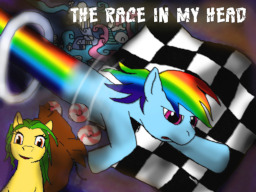
I Like Birds, part 2.
The ecology of the sky-forests surrounding Cloudsdale deserve a book in and of itself, and in fact, there are several already. The definitive guide was “An Educated Pony's Guide to The Airbourne Forests”, by Vanilla Wand. It caused quite a bit of controversy among intellectuals due to its highly contested Sequential Formation Theory. The book is highly antiquated by this point, but most of his physical descriptions and analysis have stood the test of time.
To quote:
“...Each species of the flora of the cloud have familial relation to one that rest as ground level. It is therefore not preposterous to assume that the clouds where colonized by a sequential process, whereby low-flying clouds would be infected by air-borne spores and form proto-forests at near-ground levels.
These would then bloom into mushrooms and in turn affect the clouds above them, each time displaying a drift in inheritance factors. Over time the lower cloud forests simply withered and died, leaving only those at high altitudes consisting of the most hardy of mushrooms. The few plants that can be found at this attitude where probably planted by birds resting on the cloud or else by wind. Now, some of my critics...
He goes on to respond to criticisms of his idea with thinly veiled insults and threats, all aimed at ponies who are long gone and mostly forgotten by now. It isn't until about page 147 of his book that he gives a good in-depth description of the Cloud Forest:
The South-western Cloud Forest is a solid collection of Cirrus-clouds. The cloud-type is particle-heavy and semi-temperate, but with a higher degree of humus-particles than normal. Its shape and consistency however, is largely formed by an abundance of mycelia going trough the clouds, giving it its characteristic ridge-shape.
Because of the peculiar conditions in place, the fruiting bodies can grow to massive size. The spores create a micro-weather around the mushrooms that results in complex system of fractal-shaped clouds surrounding the top of the sporing body. The cloud complexes almost warrant more study than the mushrooms themselves..
...and that is really just the tip of the thundercloud, the Cloud Forest is simply like nothing you can find anywhere else.
If you had extremely good eye-sight you could probably see a small, yellow and pink smudge somewhere in the fog at the base of the Cloud Forest. Fluttershy had found a pretty good spot, far enough in not to startle the birds, but still close enough to the edge that most of the sky was available to her.
She called out a careful “pish-pish-pish” and waited patiently. The sky remained bright blue, uncolored by any birds, but she didn't mind.
“The birds will come eventually”, she thought to herself, and sure enough, after some time, there was a bit of a stir.
Flutteshy prepared her binoculars as a large magpie flew up form inside the fog. She had already seen magpies several times though and she was hoping for something rarer. She closed her eyes for a moment to focus on the atmospheric sounds. The wind was blowing, but it was carrying with it a small bird cry.
“green-eggs-and-ham, green-eggs-and-ham”, it said.
Oh, what could it be? Fluttershy didn't have a mental archive, she stored all important knowledge under rocks in a peaceful grove inside of her mind. She tipped back the stone containing the memories of all bird cries she's ever heard and let them echo across the forest in her head. It had the same bubbly intonation as an Aracuan bird, but lacked the fast, goofy quality. It had the same rhythm as that of a Panchito pisiformis, but the wrong tone, and what was with the slight buzz at the end?
She opened her eyes again and watched the sky.
There was a small splash of color clashing against the sky, a yellow and black smudge. Fluttershy tried to make herself invisible as the smudge turned into the contours of a bird. It had a yellow belly and black wings, and when it drifted closer to Fluttershys hiding place, she could see it had a somewhat disgruntled expression on its face. It lapped water out of the spring as Fluttershy worked on identifying the bird. It was a distinctive enough bird, so identification was easy, she read its entry in the “The Birds of Equestria - a field guide”:
Tunderbird (Alcedo luminarium); 28 to 35 cm, 140 to 170 grams. Common in the Storm Mountains of Eastern Equestria, rare elsewhere. Body stocky, head large with conspicuous ragged double-pointed crest that covers the entire pileum from the base of the bill to the nape. A nearly complete yellow collar across the hindneck contrasts with the uniformly black dorsum. Creates thunderstorms, and is generally accompanied by heavy rainfall.
“Oh dear...”, Fluttershy said to herself.

